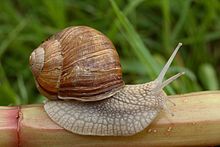Helicoidea is a taxonomic superfamily of air-breathing land snails, terrestrial pulmonate gastropod mollusks in the clade Stylommatophora.
| Helicoidea | |
|---|---|
 | |
| Helix pomatia, the Roman snail | |
| Scientific classification | |
| Domain: | Eukaryota |
| Kingdom: | Animalia |
| Phylum: | Mollusca |
| Class: | Gastropoda |
| Subclass: | Heterobranchia |
| Order: | Stylommatophora |
| Infraorder: | Helicoidei |
| Superfamily: | Helicoidea Rafinesque, 1815 |
| Famillies | |
See text. | |
Taxonomy
2017 taxonomy and latest developments[1][2][3][4]
The Bouchet et al. 2017[1] nomenclator provides an up to date system of Helicoidea. The system is in some parts preliminary, as the authors relied on unpublished (as of 2023) phylogenomic study, which did not include all New World taxa. They classified Epiphragmophoridae, Helminthoglyptidae, Humboldtianidae, Monadeniidae and Xanthonychidae (provisionally also Lysinoidae and Echinichidae) as subfamilies of the last taxon, because there are no deep splits between them in the cited unpublished study (see also Koene & Schulenburg 2005[5]).
Cepolidae, Labyrinthidae and Thysanophoridae constitute the sister group of the remaining Helicoidea.[1]
- Cepolidae Ihering, 1909
- Labyrinthidae Borrero, Sei, Robinson & Rosenberg, 2017
- Thysanophoridae Pilsbry, 1926
- Camaenidae Pilsbry, 1895
- Polygyridae Pilsbry, 1895
- Helicidae Rafinesque, 1815
- Elonidae Gittenberger, 1977
- Trissexodontidae H. Nordsieck, 1987
- Helicodontidae Kobelt, 1904
- Sphincterochilidae Zilch, 1960
- Geomitridae C. Boettger, 1909
- Canariellidae Schileyko, 1991
- Hygromiidae Tryon, 1866
- Pleurodontidae Ihering, 1912
- Trichodiscinidae H. Nordsieck, 1987
- Xanthonychidae Strebel & Pfeffer, 1879
- Echinichinae F. G. Thompson & Naranjo-Garcia, 2012
- Lysinoinae Hoffmann, 1928
- Monadeniinae H. Nordsieck, 1987
- Humboldtianinae Pilsbry, 1939
- Helminthoglyptinae Pilsbry, 1939
- Epiphragmophorinae Hoffmann, 1928
- Xanthonychinae Strebel & Pfeffer, 1879
2015 taxonomy
Razkin et al. (2015)[6] reorganized classification into monophyletic taxa according to the molecular phylogeny. This study is focus on Western Palaearctic species. The Hygromiidae s.l. family was divided into three families, Canariellidae, Geomitridae and Hygromiidae. Moreover, the family Cochlicellidae was including within the Geomitridae family as a tribe (Cochlicellini).
The classification proposed for Western Palaearctic Helicoidea is as follows:
- Bradybaeninae, subfamily of Camaenidae
- Camaenidae
- Canariellidae
- Elonidae
- Geomitridae
- Geomitrinae
- Cochlicellini
- Geomitrini
- Plentuisini
- Ponentinini
- Helicellinae
- Cernuellini
- Helicellini
- Trochoideini
- Geomitrinae
- Helicodontidae
- Helicidae
- Ariantinae
- Helicinae
- Allognathini
- Helicini
- Otalini
- Thebini
- Murellinae
- Humboldtianidae
- Hygromiidae
- Ciliellinae
- Hygromiinae
- Leptaxinae
- Sphincterochilidae
- Trissexodontidae
- Gittenbergeriinae
- Trissexodontinae
2012 taxonomy
Thompson & Naranjo-García (2012) described a new family Echinichidae and placed it to the superfamily Xanthonychoidea.[7] Therefore, the family Xanthonychidae was moved from Helicoidea to Xanthonychoidea.
2005 taxonomy
There are 19 families within the superfamily Helicoidea according to the taxonomy of the Gastropoda by Bouchet & Rocroi, 2005.[8][9]
- Helicidae
- Bradybaenidae
- Camaenidae
- Cepolidae
- Cochlicellidae
- Elonidae
- Epiphragmophoridae
- Halolimnohelicidae
- Helicodontidae
- Helminthoglyptidae
- Humboldtianidae
- Hygromiidae
- Monadeniidae
- Pleurodontidae
- Polygyridae
- Sphincterochilidae
- Thysanophoridae
- Trissexodontidae
- Xanthonychidae
According to H. Nordsieck[10] the family Xanthonychidae (sensu Hausdorf & Bouchet) is probably polyphyletic (contains several different lineages) and therefore should be divided into several families.